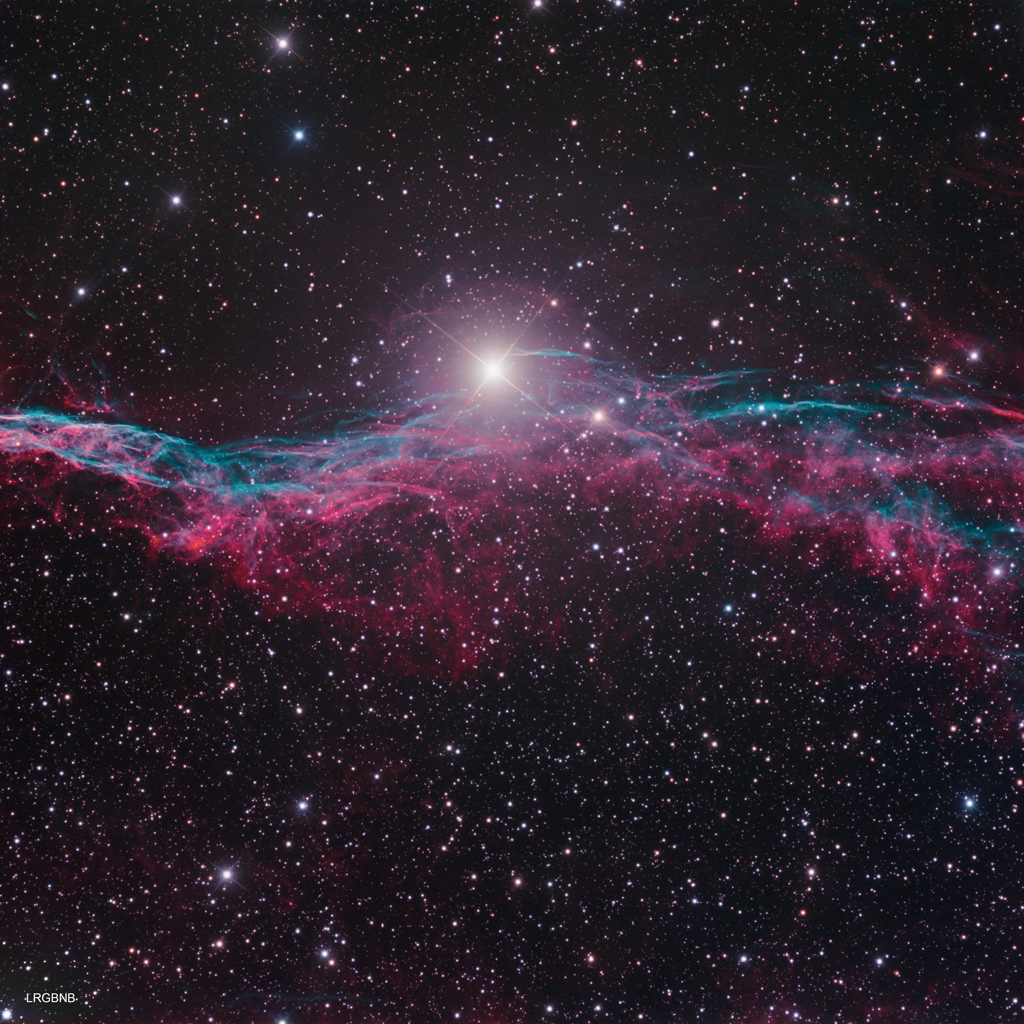HOME
NGC6960
NGC6960
Western Veil Nebula
Supernova Remnant in Cygnus
Click here for higher-resolution versions: 40% (1638x1638) 65%
(2662x2662) 100% (4096x4096)  Click on image to cycle through the five versions of the image (described below and labeled on the lower left corner of each image)
Click on image to cycle through the five versions of the image (described below and labeled on the lower left corner of each image)
NGC6960 is the largest piece of a widely-dispersed supernova remnant, emanating from a huge star that exploded about 10,000 years ago. The spectacular colors are a result
of the fact that the visible nebula consists largely of ionized hydroge gas (the red parts) and ionized oxygen gas (the blue-green part). The gas from the explosion are expanding at the rate of about
1.5 million km/hour (900,000 miles per hour).
The nebula is about 2100 light years from Earth (nobody really knows apparantly, since estimates range from 1400 light years to 2500 light years); at that distance, this piece of the nebula is roughly
23 light years across. Visually, it is a bit wider than a full moon. When the light from the explosion reach earth, the explosion would
have been visible on earth during the day. The very bright star near the center of the image is 52 Cygni, a magnitude 4 star (easily visible to the naked eye, except near large cities); this star
is only about 200 light years from us, so it is not in any way associated with the nebula, other than being in the line of sight.
I have presented this object in five different formats (each image is labeled in the lower left corner); I very much like each one in its own way. This is the order in which they appear as you cycle
through (by repeatedly clicking on the photo, waiting for each to download):
(i) A true-color version (the top photo in the stack), with the color created by imaging through red, green and blue filters (with a significant amount of Ha and OIII
data blended into various channels, in varying percentages; Ha emissions are in the red spectrum, and OIII emissions are blue-green, so I have blended Ha into the luminance layer and the red channel,
and OIII into the Luminance layer and the green and blue channels). I suspect that results in accurate colors, and I like the vibrance of the image;
(ii) A bi-color version (almost true-color version; the second photo in the stack), in which "red" is from ionized hydrogen emissions (Ha), and the green and blue channels
both are doubly-ionized oxygen emissions (OIII), which are blue-green in color. It's a fair substitute for having red, green and blue channels, but, because the green and blue channels are the same,
there is a lot of blue-green color);
(iii) A true-color version, without any contribution from Ha or OIII. IMO, this is not nearly as pleasing as either the LRGBNB or HOO version above, but is shown since
it still is the most popular way of taking images. The nebula is not nearly as prominent in this version as in the LRGB with
Ha and OIII blended in, and the colors are slightly different (also, the very bright star masks much of the central part of the nebula);
(iv) A pure Ha version (grayscale, showing only light in the very narrow Ha band); this is fun for me to gaze at in full resolution, to see all the detail;
(v) A pure OIII version (grayscale, showing only light in the very narrow OIII band); it's interesting to compare this to the pure Ha version, and also to the color versions, and to
see how closely the two narrow-band images map into the color versions.
This is the second time I have imaged this target; the first time was 17 years before I took this version, with fairly elemental equipment (at least by
comparison), and from my own yard. If you want to see if there has been any improvement, click here.
Technical Information:
Ha:OIII:L:R:G:B: 570:540:555:210:180:240 (a total of over 38 hours of light-frame exposure time); luminance, red and green exposures were all 15-minute exposures;
blue all 20-minute exposures; Ha and OIII were all 30-minute exposures.
Equipment: RC Optical Systems 14.5 inch Ritchey-Chretien carbon fiber truss telescope, with ion-milled optics and RCOS field flattener, at about f/9, and an SBIG STX-16803 camera with
internal filter wheel (SBIG filter set), guided by an SBIG AO-X, all riding on a Bisque Paramount ME German Equatorial Mount.
Image Acquisition/Camera Control: Maxim DL, controlled with ACP Expert/Scheduler, working in concert with TheSky X.
Processing: All images calibrated (darks, bias and sky flats), aligned and combined in Pixinsight. Color combine in Pixinsight. Some finish work (background neutralization,
color calibration, deconvolution and noise reduction) done in Pixinsight; some cleanup finish work was done in Photoshop CC.
Location: Data acquired remotely from Sierra Remote Observatories, Auberry, California, USA.
Date: Images taken on many nights in June, July and August of 2021. Image posted September 15, 2021.
Date: Image scale of full-resolution image: 0.56 arcseconds per pixel.
Seeing: Generally quite good, with individual calibrated luminance frames varying from 1.6 to 2.4 arcsecond FWHM.
CCD Chip temperature: -25C
Copyright 2021 Mark de Regt
